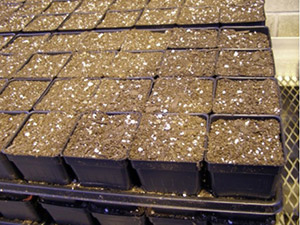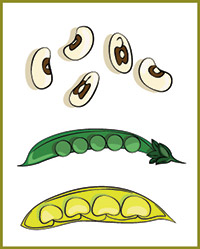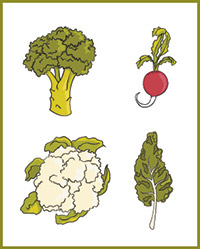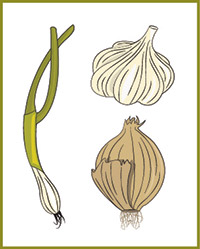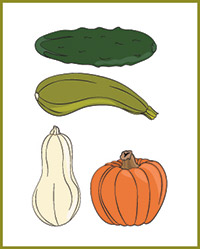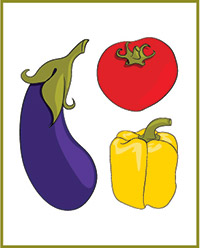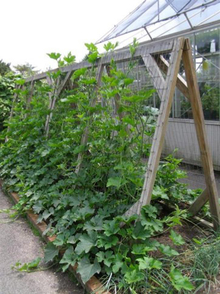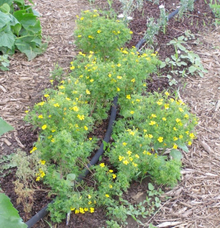Quick facts
The same practices help reduce many garden diseases. You are likely to see some disease present in the garden, but even plants with some level of disease can still produce a bountiful harvest.
- Purchase disease-free seeds and transplants.
- Plant in a location where no plant of the same family has been grown for 2 to 4 years.
- Create conditions that favor plant growth and limit fungi and bacteria by using proper plant spacing, staking, mulching and watering.
- Look for disease problems early in the season.
- Remove infected plant parts from the garden.
Spots, rots, wilts and other plant problems often appear in the vegetable garden. Below are a few strategies to keep plant diseases at a tolerable level.
Remember the goal is a good harvest of tasty vegetables. It's okay to tolerate low levels of plant disease.
Start your garden right
Seeds
- Look for disease-resistant or tolerant varieties of disease problems you have seen in the past.
- Purchase seed from a reputable source.
- If saving your own seed, collect seed only from healthy plants.
- If you suspect the seed may be contaminated, soak in 1:4 bleach solution for 1 minute and rinse in running water for 5 minutes just before planting.
- If starting seeds indoors, use new potting mix with new pots or pots cleaned with 10% bleach.
- Keep soil moist but not soggy.
- Provide good air movement around plants.
- When starting seeds in the garden, wait until the soil is warm enough to plant outside.
Clean your pots and tools
Remove all dirt and plant debris from:
- Used pots.
- Garden tools.
- Plant supports, like trellises and cages.
Clean everything with a 10% bleach solution before using in the garden. (Mix 1 cup bleach to 9 cups water.)
Transplants
- Purchase healthy transplants from a local, reputable grower.
- Inspect all transplants before purchase.
- Reject any plant with dark, discolored or soft sunken spots on leaves, stems or roots.
Rotate crops
Plant in a location where no member of the same plant family has been grown for 2 to 4 years. For instance, don't plant tomatoes in the same place you grew eggplant 2 years ago.
The bean family includes:
- Black-eyed peas
- Green beans
- Green peas
- Lima beans
- Pinto beans
- Sugar snap peas
- String beans
The cabbage family includes:
- Bok choy
- Broccoli
- Cabbage
- Cauliflower
- Collard greens
- Kale
- Mustard greens
- Radish
The onion family includes:
- Garlic
- Leeks
- Red onions
- Scallions
- Shallots
- Yellow onions
The squash family includes:
- Acorn squash
- Butternut squash
- Cucumber
- Gourds
- Pumpkin
- Winter squash
- Zucchini
The tomato family includes:
- Chili peppers
- Eggplant
- Green, yellow and red peppers
- Ground cherries
- Potatoes
- Tomatillos
- Tomatoes
Manage disease throughout the season
Monitor for problems
Diseases are easier to deal with if identified early. Once a disease is severe, there is little that can be done.
- Examine plants once a week throughout the gardening season.
- Use the online diagnostic tool What's wrong with my plant?
- For plants you really value, you can send a plant sample to the UMN Plant Disease Clinic.
Manage moisture
- Fungi and bacteria thrive in humid conditions.
- Use drip irrigation or water with a sprinkler early in the day so the plants dry quickly in the sun.
- Space plants for good air movement so plants dry quickly after rain or dew.
- Stake vining plants like cucumber, beans, and tomatoes.
- Mulch to completely cover the soil with plastic or organic mulch like straw or woodchips.
- Do not work in plants when leaves are wet. Fungi and bacteria easily spread under these conditions.
Manage weeds
- Weeds crowd the crop and increase humidity on leaves and fruit.
- Weeds steal nutrients and water from plants, resulting in plant stress.
- Many pathogens can survive on weeds and then move into the crop.
Remove diseased plant material
- Completely remove plants infected with a virus or aster yellows.
- Pinch off leaves infected with leaf spots and remove them from the garden. Never remove more than 1/3 of a plant's leaves.
- Remove rotten produce from the garden to prevent the spread to developing produce.
- Do not harvest rotten and ripe produce together or rot may spread in storage.
- At the end of the growing season completely remove diseased plants.
- Diseased plant material can be composted if the compost pile gets hot enough (148°F or more) and the plants completely break down.
- If your garden is very large, bury plant debris so it can begin to decay and plant a different plant family in that location the following year.
Reviewed in 2024


